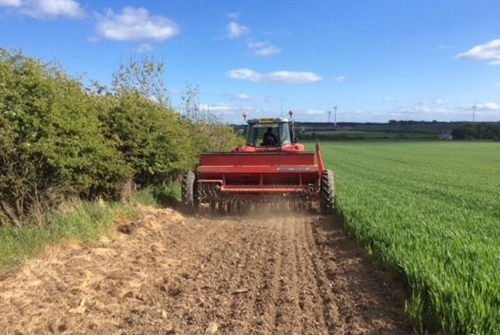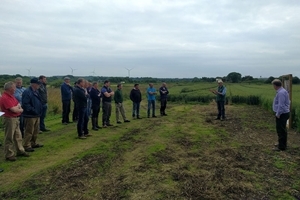Balgonie Estate lies just east of Glenrothes, in Fife, and is an open, arable farm of approximately 750 ha. Our project here, to encourage the modest grey partridge population to increase, began in 2014 when we started surveying grey partridge and songbird numbers before habitat changes were implemented in 2015.
These changes comprised almost 7km of 4m-wide strips of chicory and mustard sown round the farm. This simple mix was chosen because we wanted to try to develop a long-term cover crop (chicory) that might make life simpler for farmers by removing the need for frequent resowing.
 Sowing of chicory and mustard headlands at Balgonie in 2015.
Sowing of chicory and mustard headlands at Balgonie in 2015.
By and large, the headlands have flourished and provide good year-round cover. The farm team cut small patches into the edges of the headlands every year to create a more open, short structure, which we hope will be better suited to grey partridge chicks and other birds that might otherwise struggle to access the crop. This is very important because a headland rich in invertebrates could be potentially vital for young birds that need lots of bugs in their diets, but if they can’t get at them it is useless.
This has thrown up some agronomic issues, with persistent weeds getting a foothold in some of the plots, and an important part of this project is to develop guidelines on how best to deal with and manage this. In this regard in particular, our partners at Kings, Scottish Agronomy and Kingdom Farming are providing invaluable assistance.
The early results of the monitoring programme have been telling: breeding songbird numbers (for those species in the Scottish Terrestrial Breeding Birds index for farmland) increased by around 75%, and winter numbers of all songbirds increased more than fourfold. Grey partridge have increased too, with autumn densities double what they were at the start of the project as a result of better productivity and probably adult survival during breeding, although the number of spring pairs has remained pretty stable.

Grey partridge counts at Balgonie since the start of the project. (Counting in spring 2017 wasn’t possible).
2014 was the baseline year, with new habitats introduced in spring 2015.
 Balgonie has been part of the GWCT-led PARTRIDGE project and, as such, has introduced more new habitats. These include a new mix of around a dozen species that form another potentially long-term cover-crop option for farmers, although some cutting is required annually. We hope that this simple option might be popular amongst farmers and so increase the amount of grey partridge habitat in the countryside.
Balgonie has been part of the GWCT-led PARTRIDGE project and, as such, has introduced more new habitats. These include a new mix of around a dozen species that form another potentially long-term cover-crop option for farmers, although some cutting is required annually. We hope that this simple option might be popular amongst farmers and so increase the amount of grey partridge habitat in the countryside.
An important focus of the PARTRIDGE project is in sharing our findings with other farmers and policy makers so we might help improve land management elsewhere and perhaps policies that help farmers manage the land sympathetically. Every summer we have events on the farm, led by Scottish Agronomy, at which many farmers visit to take a look at the various activities on the farm. This is an important opportunity to try to encourage others to introduce some wildlife habitats on their own land.